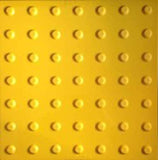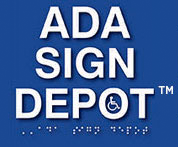What are all these Yellow Pads with Bumps on street corners?
ADA Sign Depot
August 30, 2013
What are all these Yellow Pads with Bumps on street corners?

Sight Impaired People Use ADA Truncated Dome Pads for increased safety and independent mobility.
So, yeah. Tell me. All those yellow pads with bumps on them. I see them on more and more street corners, and along train platforms, and on wheelchair ramp entrances to buildings. What are they? Who put them there? And why?
What are they? Truncated domes.
Who put them their? Truncated domes on public property were installed by a a federal, state or local government. On private property, the property owner installed the pads to bring their property into compliance with current ADA law.
Why? Safety. Mobility. Independence. In a word, Access. But perhaps the fullest answer to why truncated domes are being installed on more and more public and property properties is to glance over the ADA history with these tactile paving pads.
A Timeline for the Use and Acceptance of Truncated Domes by the ADA
1991: Detectable Warning Surfaces were first required with the release of the Americans with Disabilities Act Accessibility Guidelines. Detectable Warnings were required on hazardous vehicle ways, transit platform edges, and curb ramps.
1994-2001: A suspension was placed on the requirements with the exception of transit platforms so that research could be conducted on the detectability of the varying tactile surfaces such as grooves, striations, and exposed aggregate. When completed, the research determined that those surfaces were in fact not detectable due to the similarities to normal surface defects found on sidewalks and roadways.
July 26th, 2001: The suspension regarding tactile warnings was allowed to expire and truncated dome detectable warnings specified in the ADAAG were again required.
2001-Present: Truncated Domes are an Americans with Disabilities Act (ADA) requirement in the current Americans with Disabilities Act Accessibility Guidelines (ADAAG) for the use of detecting the boundary between the sidewalk and the street. Truncated domes are the only detectable warnings allowed by ADAAG. Grooves, exposed aggregate, and other designs intended for use as detectable warning are too similar to pavement textures, cracks and joints and are not considered equivalent facilitation. Truncated domes are a unique design and have proven to be the most detectable surface.
- Tags: ADA Pads and Truncated Domes Subscribe to this blog's RSS feed.



